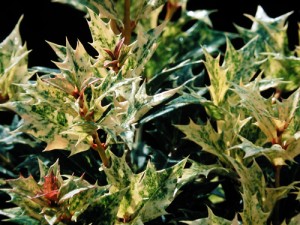Winter is a good time to assess just how colorful your landscape is! It’s very easy when planning a landscape to create a great spring and summer display, but the trick to creating year around color in your landscape is selecting from plants that bloom each season. I will try to lay out over the next couple weeks and months plants that you can add into your landscape that will bring it year-round interest and create focal changes as the seasons progress. A lot of these plants I’ve used for years in my landscape designs as well as my home landscape. Just walking around yesterday I realized how Yellow Twig Dogwood, Edgeworthia and other winter plants create an interest even on the dreariest of days.

Osmanthus heterophyllus ‘Goshiki’ is a tough, strikingly variegated evergreen shrub with five colors on each leaf which create an eye-catching display in the landscape.
For starters, let’s look at Goshiki Osmanthus. This great mounding evergreen shrub has variegated foliage throughout the year with interesting color changes as the new foliage comes out and the later summer foliage matures. It is a slow growing shrub that loves to be pruned hard so it’s adaptable in small spaces and, if left untreated, can grow 4 to 5 feet tall, which makes it very adaptable for many areas in your landscape. For those of you who get creative around the holidays, its foliage works very well in Christmas wreaths and holiday greenery. Goshiki means ‘five colored’ in Japanese and refers to the various colors found on each leaf. The leaves will show off all five colors: cream, pink, orange, yellow, and white. Those colors will appear in attractive spots or swirls that combine together to create an eye-catching display!
Other notes: Thrives in dry, hot climates, good container plants, drought tolerant, fragrant, low maintenance
Learn more about Unique Environmental.






